Aorus KD25F 240 Hz Gaming Monitor Review: Breaking Our Benchmark Records
Why you can trust Tom's Hardware
Grayscale, Gamma and Color
The KD25F was tested in its Standard picture mode, both in a default state and after calibration. Other picture modes may be suitable for different gaming types, but we prefer to stick with a single mode for all applications. Users can adjust gamma, grayscale and color saturation, then save those settings to one of three memories for later recall.
Grayscale and Gamma Tracking
We describe our grayscale and gamma tests in detail here.
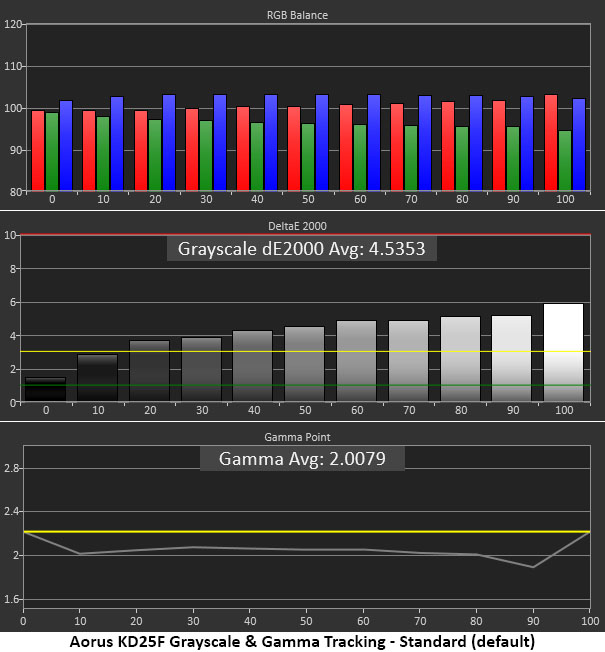
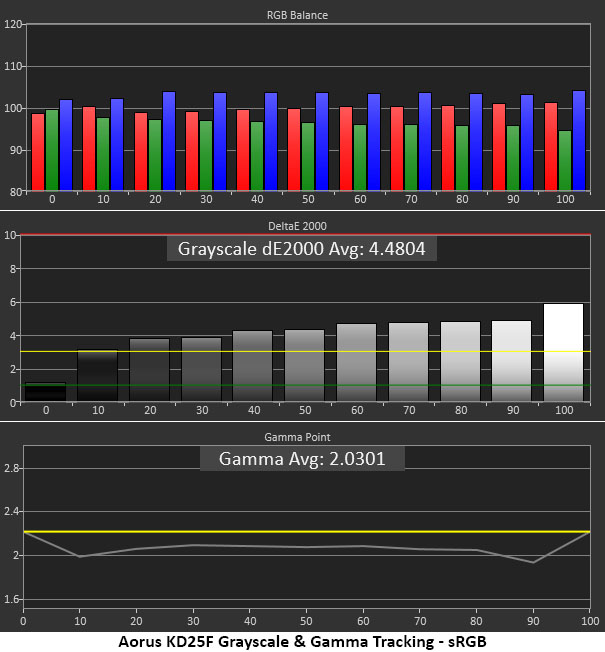
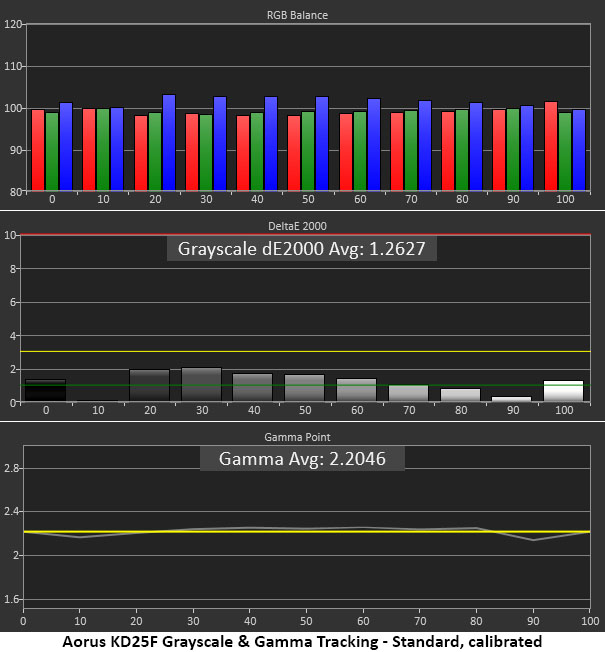
Out of the box, the KD25F’s grayscale tracking was a bit cool with a slight purple tint visible from 20-100% brightness. The error was slight and may not be an issue for some users. Our greater concern is the gamma tracking. Although it’s nicely linear, it runs below the 2.2 line, making images washed-out and flat.
Changing the preset from 3 to 4 takes care of that problem. You can see in the second chart that the KD25F’s sRGB mode offered no improvement. It also locked out all luminance controls and fixed brightness to 150 nits max.
After calibrating the RGB sliders and changing the gamma preset, we have a much better-looking chart (third photo). All errors are now at a Delta E (dE) of less than 3, with most below 2dE. Gamma is right on the 2.2 line with tight tracking. This improved image depth and added a bit of color saturation, which you’ll see below in the color gamut test results.
Comparisons
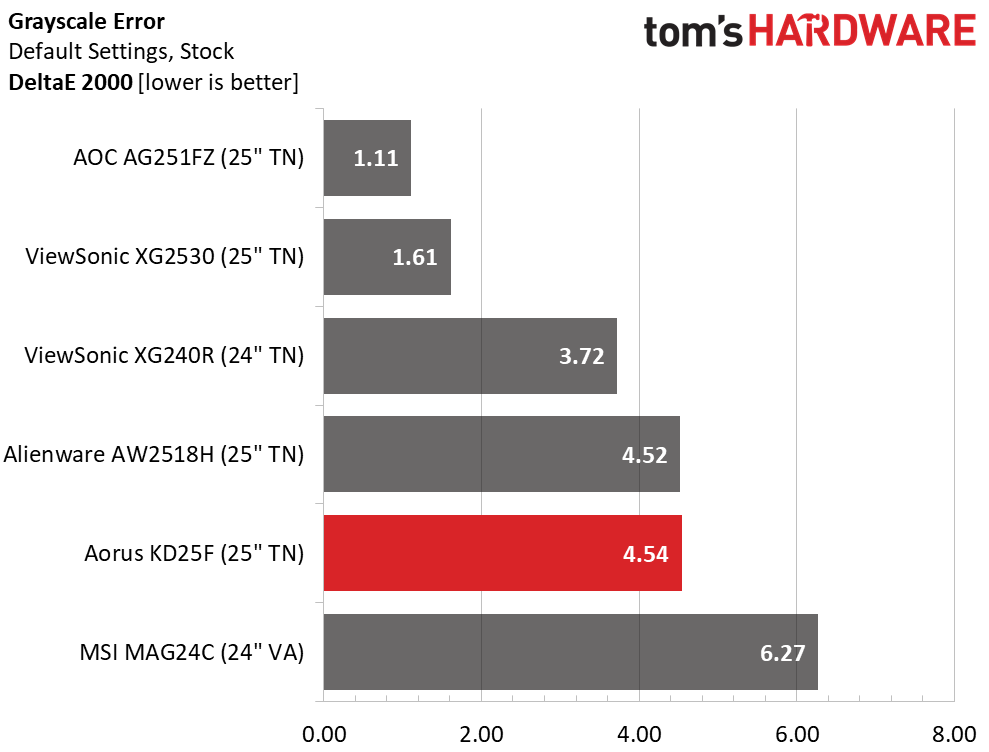



4.54dE isn’t too bad for an out-of-box result, but the AG251FZ and XG2530 posted better default grayscale scores. If you dial in our recommended values, however, you’ll see essentially perfect white balance. With calibration, all the monitors here perform very well.
Changing the gamma preset from 3 to 4 put the KD25F in the top spot of the group. This really improved image depth, especially with relatively low contrast (like all the TN monitors here). With a tight 0.13 range of values and perfect 2.2 average, it doesn’t get better.
Get Tom's Hardware's best news and in-depth reviews, straight to your inbox.
Color Gamut Accuracy
For details on our color gamut testing and volume calculations, click here.
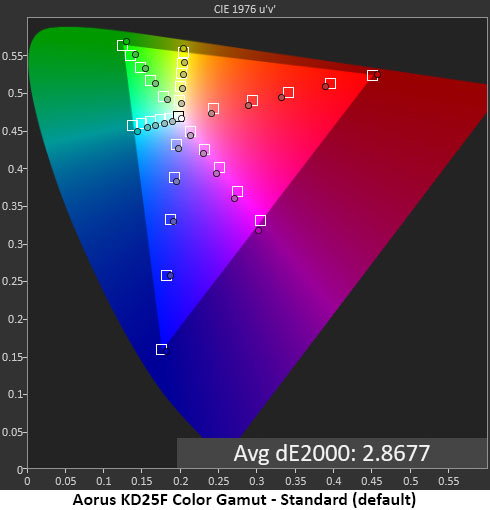


At its default settings, the KD25F tracked the sRGB gamut accurately, but the inner color targets were slightly under-saturated. This isn’t a huge issue, but it made the image a bit dull.
The sRGB mode is much the same as Standard. You can increase the Color Vibrance slider, which helps somewhat, but it isn’t as effective as changing the gamma preset and calibrating the white balance.
In the final chart, the average error is slightly lower, but the increase in overall color saturation was easily seen when viewing actual content. We highly recommend copying our recommended calibration settings, to get the most from your KD25F.
Comparisons
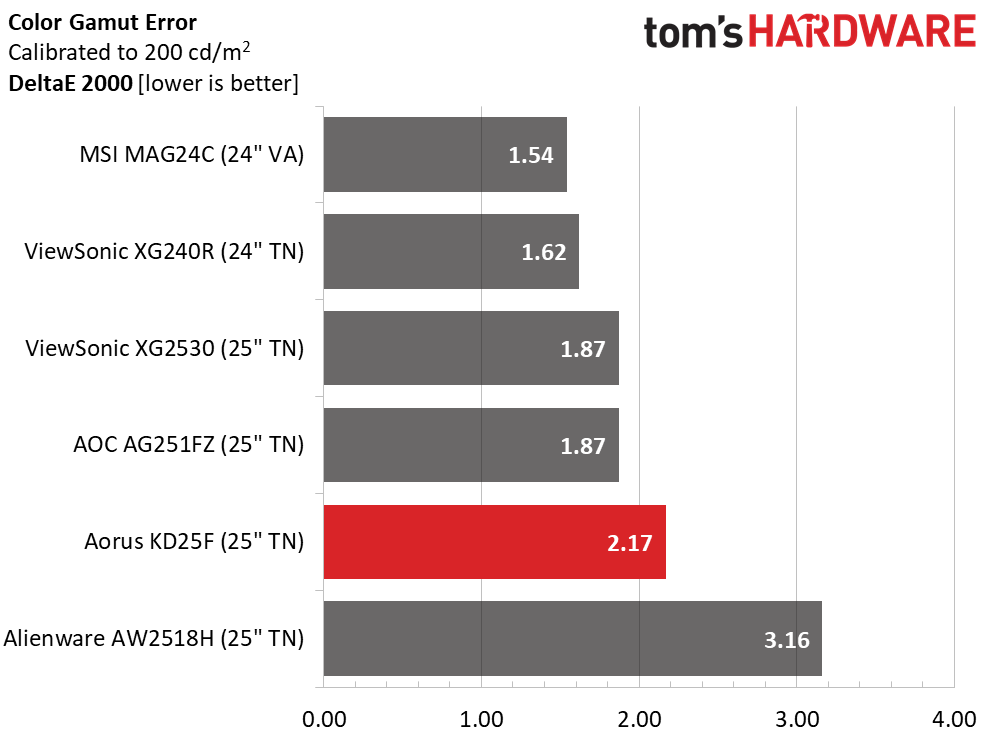

Calibration took the KD25F’s average color error from 2.87dE to 2.17dE. While that doesn’t sound like much, the increased saturation was easy to see. It’s mainly due to the change in gamma preset. That setting alone made a visible impact.
In the gamut volume calculation, the KD25F hit all the marks with a 101.89% score. Its color tracking at all saturation levels, coupled with a full sRGB volume, qualify it for color-critical duty. While it’s aimed squarely at gaming, it’s nice to see Aorus putting effort into color accuracy.
MORE: Best Gaming Monitors
MORE: How We Test Monitors
MORE: All Monitor Content
Current page: Grayscale, Gamma and Color
Prev Page Brightness and Contrast Next Page Viewing Angles, Uniformity, Response and Lag
Christian Eberle is a Contributing Editor for Tom's Hardware US. He's a veteran reviewer of A/V equipment, specializing in monitors. Christian began his obsession with tech when he built his first PC in 1991, a 286 running DOS 3.0 at a blazing 12MHz. In 2006, he undertook training from the Imaging Science Foundation in video calibration and testing and thus started a passion for precise imaging that persists to this day. He is also a professional musician with a degree from the New England Conservatory as a classical bassoonist which he used to good effect as a performer with the West Point Army Band from 1987 to 2013. He enjoys watching movies and listening to high-end audio in his custom-built home theater and can be seen riding trails near his home on a race-ready ICE VTX recumbent trike. Christian enjoys the endless summer in Florida where he lives with his wife and Chihuahua and plays with orchestras around the state.
-
AlistairAB The Alienware one I bought seemed defective, as OD error was atrocious at 240hz and wasn't adjustable regardless of OD setting. Setting the monitor back to 144hz fixed all the problems. I hope the Aorus isn't the same.Reply
Lipstick on a pig somewhat, as we already have a vastly superior and responsive technology, OLED. Would kill for a 25" 240hz OLED monitor instead, with even faster response times standard. -
thealmightyeyeball I have the Alienware AW2518HF. It is flawless as far as freesync is concerned. It is also about 150 dollars less.Reply
I would get the Alienware. -
Theodore Juices There's an updated version of the AOC AG251FZ, the AG251FZ2. I know because I just owned it for a month before returning it for reasons unrelated to its performance. Why didn't you compare this monitor to that one instead? That would have been much more useful.Reply -
zeekez I just got this monitor, I love it so far but I have a few questions, mainly, does Aim Assist need to be on for the fastest input speed? I've noticed with Aim Assist it dims the screen considerably. I was just curious if the config given for the best color was with it on or off.Reply -
Demi9OD Replyzeekez said:I just got this monitor, I love it so far but I have a few questions, mainly, does Aim Assist need to be on for the fastest input speed? I've noticed with Aim Assist it dims the screen considerably. I was just curious if the config given for the best color was with it on or off.
I think Aim Assist is the Black Frame Insertion feature. You don't need it on and it probably slows down input speed a little bit.